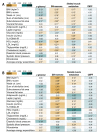Metabolomic Profiles in Childhood and Adolescence Are Associated with Fetal Overnutrition
- PMID: 35323708
- PMCID: PMC8952572
- DOI: 10.3390/metabo12030265
Metabolomic Profiles in Childhood and Adolescence Are Associated with Fetal Overnutrition
Abstract
Fetal overnutrition predisposes offspring to increased metabolic risk. The current study used metabolomics to assess sustained differences in serum metabolites across childhood and adolescence among youth exposed to three typologies of fetal overnutrition: maternal obesity only, gestational diabetes mellitus (GDM) only, and obesity + GDM. We included youth exposed in utero to obesity only (BMI ≥ 30; n = 66), GDM only (n = 56), obesity + GDM (n = 25), or unexposed (n = 297), with untargeted metabolomics measured at ages 10 and 16 years. We used linear mixed models to identify metabolites across both time-points associated with exposure to any overnutrition, using a false-discovery-rate correction (FDR) <0.20. These metabolites were included in a principal component analysis (PCA) to generate profiles and assess metabolite profile differences with respect to overnutrition typology (adjusted for prenatal smoking, offspring age, sex, and race/ethnicity). Fetal overnutrition was associated with 52 metabolites. PCA yielded four factors accounting for 17−27% of the variance, depending on age of measurement. We observed differences in three factor patterns with respect to overnutrition typology: sphingomyelin-mannose (8−13% variance), skeletal muscle metabolism (6−10% variance), and 3-carboxy-4-methyl-5-propyl-2-furanpropanoic acid (CMPF; 3−4% variance). The sphingomyelin-mannose factor score was higher among offspring exposed to obesity vs. GDM. Exposure to obesity + GDM (vs. GDM or obesity only) was associated with higher skeletal muscle metabolism and CMPF scores. Fetal overnutrition is associated with metabolic changes in the offspring, but differences between typologies of overnutrition account for a small amount of variation in the metabolome, suggesting there is likely greater pathophysiological overlap than difference.
Keywords: childhood; gestational diabetes mellitus; metabolomics; obesity; pregnancy.
Conflict of interest statement
The authors declare no conflict of interest. The funders had no role in the design of the study; in the collection, analyses, or interpretation of data; in the writing of the manuscript, or in the decision to publish the results.
Figures


References
-
- Lowe W.L., Jr., Scholtens D.M., Lowe L.P., Kuang A., Nodzenski M., Talbot O., Catalano P.M., Linder B., Brickman W.J., Clayton P., et al. Association of gestational diabetes with maternal disorders of glucose metabolism and childhood adiposity. JAMA. 2018;320:1005–1016. doi: 10.1001/jama.2018.11628. - DOI - PMC - PubMed
Grants and funding
LinkOut - more resources
Full Text Sources

